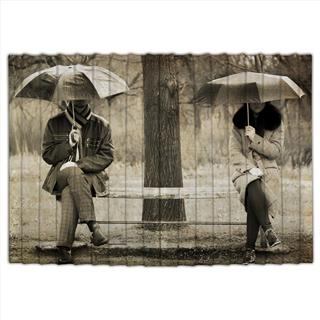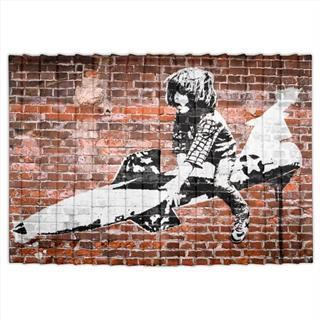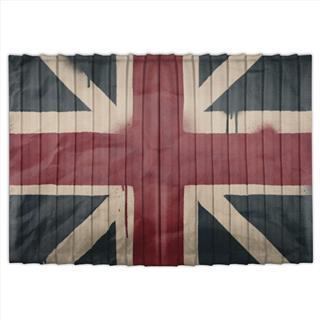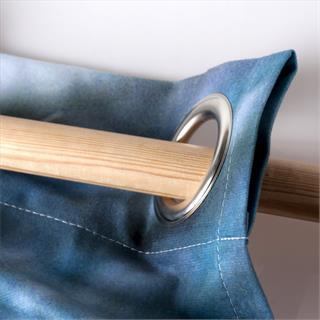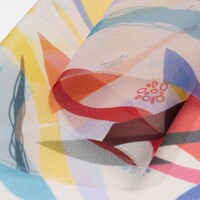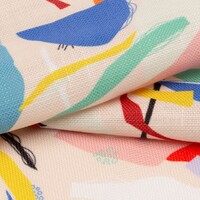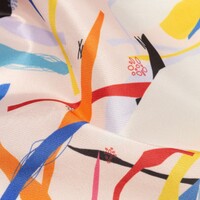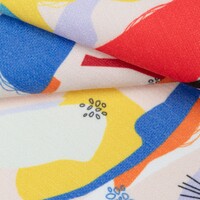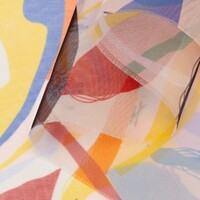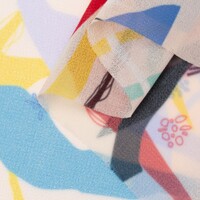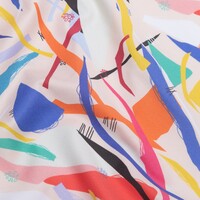Curtain Fabric Options
Choose from our wide range of curtain fabrics, from delicate lace to classic suede.
-
![Suede Vision FR]()
Suede Vision FR
-
Max Print:
1.46m
-
Weight:
250gsm
-
Roll Width:
1.48m
Soft, faux suede face with synthetic rubber back. Non fray, solid and strong. Fire rated & water repellent.
Composition:100% polyester
-
![Panama Flo]()
Panama Flo
-
Max Print:
1.47m
-
Weight:
150gsm
-
Roll Width:
1.49m
Lightweight woven poly-blend. Durable and solid with a slight spring. Soft, matt and opaque.
Composition:100% polyester
-
![Voile De Ville]()
Voile De Ville
-
Max Print:
1.49m
-
Weight:
120gsm
-
Roll Width:
1.51m
Stiff, non-fray, splash- proof woven poly. Delicate net texture with shiny face.
Composition:100% polyester
-
![Paris Chiffon (poly)]()
Paris Chiffon (poly)
-
Max Print:
1.37m
-
Weight:
40gsm
-
Roll Width:
1.39m
Silky, sheer and light. Soft woven poly. Semi-transparent with strong contrast print. Good natural drape.
Composition:100% polyester
-
![Crushed Velour]()
Crushed Velour
-
Max Print:
1.35m
-
Weight:
245gsm
-
Roll Width:
1.37m
Knitted poly fabric. Very stretchy, with a soft shimmery pile. Bright, intense colours. Retains heat well.
Composition:98% polyester 2% elastane
-
![Dorchester Linen Look FR]()
Dorchester Linen Look FR
-
Max Print:
1.36m
-
Weight:
231gsm
-
Roll Width:
1.38m
Coarse, open weave linen look fabric. Thick mesh-like textured surface. Still soft to touch. Off-white cream base tone.
Composition:100% polyester
-
![Mayfair Herringbone Weave]()
Mayfair Herringbone Weave
-
Max Print:
1.43m
-
Weight:
269gsm
-
Roll Width:
1.45m
Distinguished herringbone weave. Soft, cotton-feel. Textured on both sides. Off-white base tone.
Composition:100% polyester
-
![Velvet Shimmer]()
Velvet Shimmer
-
Max Print:
1.38m
-
Weight:
371gsm
-
Roll Width:
1.4m
Luxury shimmery face with short pile and a stiff, coarse back. Durable, holds shape well. Sharp print quality.
Composition:100% polyester
-
![Taffeta]()
Taffeta
-
Max Print:
1.43m
-
Weight:
90gsm
-
Roll Width:
1.45m
Smooth and crisp surface with lustrous sheen. Good strength and slightly stiff. Shimmery finish.
Composition:100% polyester
-
![Chenille]()
Chenille
-
Max Print:
1.45m
-
Weight:
330gsm
-
Roll Width:
1.47m
Classic chenille fabric, soft and strong. Textured caterpillar pile. Retains heat, water absorbent.
Composition:100% polyester
-
![Real 100% Silk Georgette]()
Real 100% Silk Georgette
-
Max Print:
1.38m
-
Weight:
50gsm
-
Roll Width:
1.4m
100% silk, tight weave, light and airy. Crepe-like texture with a dry handle. Soft, saturated tones.
Expected Shrinkage = Weft: 6% Warp: 9%
-
![Cotton Satin]()
Cotton Satin
-
Max Print:
1.49m
-
Weight:
172gsm
-
Roll Width:
1.51m
100% cotton, satin weave. Soft and smooth with a matt finish. Drapes easily, sharp, detailed print.
-
![Volando Voile]()
Volando Voile
-
Max Print:
1.41m
-
Weight:
52gsm
-
Roll Width:
1.43m
Very fine open plain weave. Sheer, semi-transparent, Smooth and soft.
Composition:100% polyester
-
![Poly Georgette White]()
Poly Georgette White
-
Max Print:
1.45m
-
Weight:
65gsm
-
Roll Width:
1.47m
Soft with twisted yarns. crepe textured face. Added strength from poly fibres. Natural drape, punchy detailed print..
Composition:100% polyester
-
![Mulmul Soft Muslin (poly)]()
Mulmul Soft Muslin (poly)
-
Max Print:
1.29m
-
Weight:
55gsm
-
Roll Width:
1.31m
Soft, cotton-like touch with added durability from poly fibres. Open set net-like weave similar to cheesecloth.
Composition:100% polyester
-
![Marbled Velvet]()
Marbled Velvet
-
Max Print:
1.41m
-
Weight:
220gsm
-
Roll Width:
1.43m
Stunning pile creates marbled effect. Catches the light easily, textured surface. Medium weight, soft to touch.
Composition:face : 100% poly. backing : 65% poly 35% cotton
-
![Fashion Crepe]()
Fashion Crepe
-
Max Print:
1.44m
-
Weight:
150gsm
-
Roll Width:
1.46m
Soft and matte with springy, spun yarn. Great stretch and solid construction, crepe handle to face and reverse.
Composition:100% polyester
-
![Chichi Furnishing Velour FR]()
Chichi Furnishing Velour FR
-
Max Print:
1.35m
-
Weight:
280gsm
-
Roll Width:
1.37m
Short pile makes for a super soft fabric, scrim back, opaque with slight sheen.
Composition:100% polyester
-
![Crystal Voile Cotton Silk]()
Crystal Voile Cotton Silk
-
Max Print:
1.33m
-
Weight:
40gsm
-
Roll Width:
1.35m
70% cotton 30% silk lightweight woven voile. Print shows through 90% to reverse. Super bright colours & deep blacks using reactive ink chemistry.
Composition:70% cotton 30% silk
Expected Shrinkage = Weft: 2% Warp: 1%
-
![Silhouette Organic Cotton Sateen]()
Silhouette Organic Cotton Sateen
-
Max Print:
1.74m
-
Weight:
125gsm
-
Roll Width:
1.8m
325 thread count, high quality bedding material. 100% BCI cotton (Better Cotton Initiative) . Bright white base colour, smooth luxury delicate yet durable material. 5-Star hotel bed linen quality. Wide width material at up to 175cm print width.
Composition:100% Organic cotton
Expected Shrinkage = Weft: 1% Warp: 1%
-
![100% Linen Flax Plain Weave]()
100% Linen Flax Plain Weave
-
Max Print:
1.39m
-
Weight:
143gsm
-
Roll Width:
1.41m
Medium weight 100% linen plain weave fabric. Contains characteristic slubs and bobbles, will include occasional unprinted white dots. Super bright colours & deep blacks using reactive ink chemistry. Uses: clothing, kitchen textiles, curtains, light upholstery.
Expected Shrinkage = Weft: 5.8% Warp: 1.6%
Care instructions
30°C wash, low tumble dry heat or hang to dry, do not wring.
Printed Curtain Fabric: How it Works
Step 1: Calculate dimensions
When measuring your window space, you need to account for the pleating/fullness. So for example, if your window is 1m wide, you'll need approximately 2m of curtain fabric so it doesn't look like a flat sheet when pulled across. How you plan to hang your curtains is also an important factor here. For standard pencil pleat heading, we'd suggest doubling the fullness; for eyelets, you'd need between 1.5 to 2.25 times fullness (make sure you have an even number of eyelets).
Where you plan to hang your curtains will influence the length. If they're to go within a window recess, the end of the fabric should sit just above the windowsill. For curtains hanging outside a recess, aim for 10cm below the windowsill. If you're making floor length curtains, you can easily let them finish just above the floor for easy pulling, sitting on the floor to keep draughts out or make them longer to add weight.
NB: Fabric shrinkage can be 2-6%, so we advise accounting for an additional 1cm of fabric all around, for hemming and in case of any shrinkage.
Step 2: Know the drop of your pattern
Check your pattern to see if it has a half drop repeat, half repeat, half drop pattern or whether it matches at the edges. Fabrics are limited to the width of the roll, so in cases where curtains are particularly wide, you will need to stitch separate panels together either vertically or even horizontally, resulting in your pattern meeting at the edges. (Within our design system, you can add a drop pattern/tile effect to your pattern).
Step 3: Start your design
Now you know the dimensions needed, you can begin to create your custom printed curtain fabric. Upload your design, edit it, rearrange it etc to ensure it's exactly as you want it. The preview shows the full width and length, without the pleating.
How to Care for Your Curtain Material
Our Suede Vision material for curtains can be machine washed without loss of colour at 30°. Iron on a low heat. For everyday cleaning, use a curtain nozzle attached to your vacuum cleaner to remove dust and fluff.
Due to the delicate nature of the Mulmul Soft Muslin fabric, some pulls are to be expected and this is not out of the ordinary.
Important: If you are making curtains for a non-domestic setting, i.e public space, university, hotel, it will be a requirement that the curtains are certified as fire rated. Suede Vision is fire rated to BS 5867 - 2:2008.











